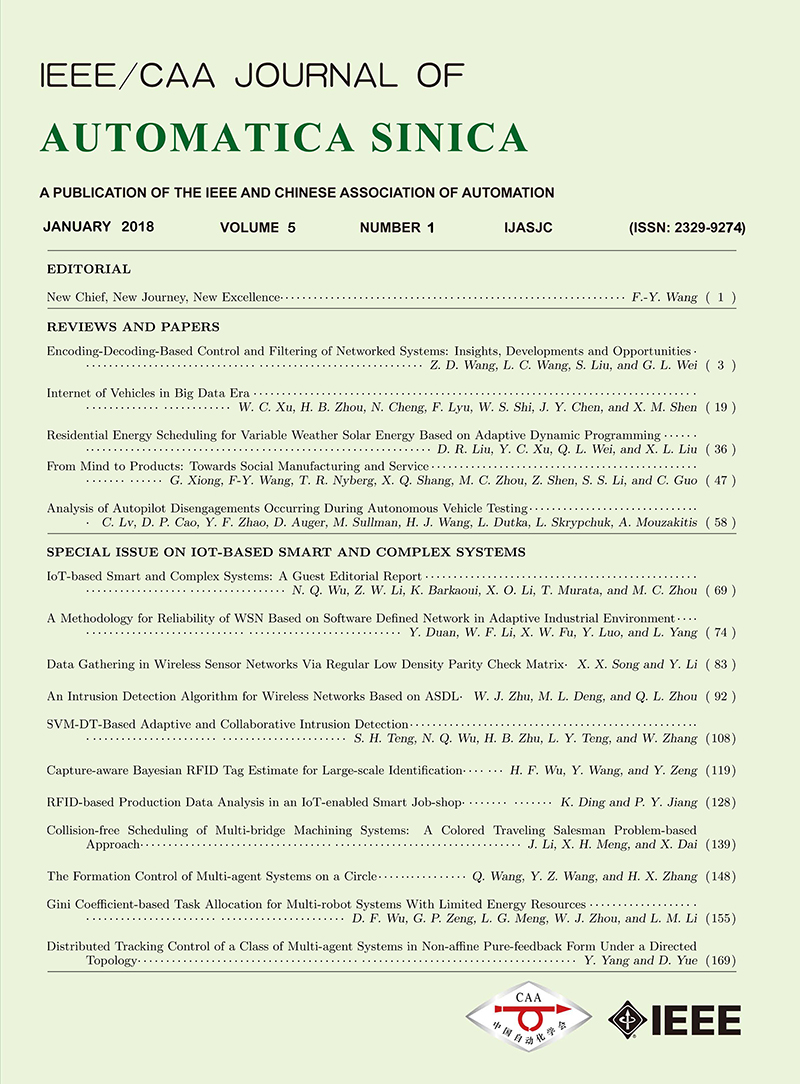 Volume 5
Issue 1
Volume 5
Issue 1
IEEE/CAA Journal of Automatica Sinica
| Citation: | Danfeng Wu, Guangping Zeng, Lingguo Meng, Weijian Zhou and Linmin Li, "Gini Coefficient-based Task Allocation for Multi-robot Systems With Limited Energy Resources," IEEE/CAA J. Autom. Sinica, vol. 5, no. 1, pp. 155-168, Jan. 2018. doi: 10.1109/JAS.2017.7510385 |

| [1] |
J. W. Kwon, "Cooperative environment scans based on a multi-robot system, " Sensors, vol. 15, no. 3, pp. 6483-6496, Mar. 2015. http://www.mdpi.com/1424-8220/15/3/6483/pdf
|
| [2] |
M. H. Kim, S. P. Kim, and S. Lee, "Social-welfare based task allocation for multi-robot systems with resource constraints, " Comp. Indust. Eng., vol. 63, no. 4, pp. 994-1002, Dec. 2012. https://www.sciencedirect.com/science/article/pii/S036083521200160X
|
| [3] |
B. P. Gerkey and M. J. Matarić, "A formal analysis and taxonomy of task allocation in multi-robot systems, " Int. J. Robot. Res., vol. 23, no. 9, pp. 939-954, Sep. 2004. doi: 10.1177/0278364904045564
|
| [4] |
W. Y. Wang and Y. C. Jiang, "Multiagent-based allocation of complex tasks in social networks, " IEEE Trans. Emerg. Top. Comput., vol. 3, no. 4, pp. 571-584, Dec. 2015. http://ieeexplore.ieee.org/document/7050301/
|
| [5] |
A. Majumder, S. Datta, and K. V. M. Naidu, "Capacitated team formation problem on social networks, " Proc. 18th ACM SIGKDD International Conf. Knowledge Discovery and Data Mining, New York, 2012, pp. 1005-1013. https://www.computer.org/web/csdl/index/-/csdl/trans/bd/2015/01/...
|
| [6] |
X. Y. Wang, Z. Zhao, and W. Ng, "A comparative study of team formation in social networks, " Lecture Notes in Computer Science, Hanoi, Vietnam, 2015, pp. 389-404. doi: 10.1007/978-3-319-18120-2_23
|
| [7] |
T. Gunn and J. Anderson, "Effective task allocation for evolving multiRobot teams in dangerous environments, " Proc. 2013 IEEE/WIC/ACM International Joint Conf. Web Intelligence (WI) and Intelligent Agent Technologies (IAT), Atlanta, GA, 2013, pp. 231-238. http://ieeexplore.ieee.org/lpdocs/epic03/wrapper.htm?arnumber=6690794
|
| [8] |
T. Gunn and J. Anderson, "Dynamic heterogeneous team formation for robotic urban search and rescue, " J. Comput. Syst. Sci., vol. 81, no. 3, pp. 553-567, May 2015. http://aalab.cs.umanitoba.ca/~andersj/Publications/pdf/GunnANT2013.pdf
|
| [9] |
P. Lanillos, E. Besada-Portas, J. A. Lopez-Orozco, and J. M. de la Cruz, "Minimum time search in uncertain dynamic domains with complex sensorial platforms, " Sensors, vol. 14, no. 8, pp. 14131-14179, Aug. 2014. http://www.mdpi.com/1424-8220/14/8/14131
|
| [10] |
L. Vig and J. A. Adams, "Market-based multi-robot coalition formation, " in Distributed Autonomous Robotic Systems, M. Gini and R. Voyles, Eds. Japan:Springer, 2006, pp. 227-236.
|
| [11] |
B. P. Gerkey and M. J. Matari, "Sold!:Auction methods for multirobot coordination, " IEEE Trans. Rob. Autom., vol. 18, no. 5, pp. 758-768, Oct. 2002. http://ieeexplore.ieee.org/document/1067996/
|
| [12] |
M. B. Dias and A. Stentz, "A comparative study between centralized, market-based, and behavioral multirobot coordination approaches, " Proc. 2003 IEEE/RSJ International Conf. Intelligent Robots and Systems, Las Vegas, NV, United States, 2003, pp. 2279-2284.
|
| [13] |
H. L. Choi, L. Brunet, and J. P. How, "Consensus-based decentralized auctions for robust task allocation, " IEEE Trans. Robot., vol. 25, no. 4, pp. 912-926, Aug. 2009.
|
| [14] |
A. Viguria and A. M. Howard, "An integrated approach for achieving multirobot task formations, " IEEE/ASME Trans. Mech., vol. 14, no. 2, pp. 176-186, Apr. 2009. http://ieeexplore.ieee.org/document/4804625/
|
| [15] |
Y. Hu, L. Wang, J. Liang, and T. Wang, "Cooperative box-pushing with multiple autonomous robotic fish in underwater environment, " IET Control Theory Appl., vol. 5, no. 17, pp. 2015-2022, Nov. 2011. http://ieeexplore.ieee.org/xpl/abstractKeywords.jsp?reload=true&arnumber=6044598&filter%3DAND%28p_IS_Number%3A6044590%29
|
| [16] |
R. Zlot and A. Stentz, "Market-based multirobot coordination for complex tasks, " Int. J. Rob. Res., vol. 25, no. 1, pp. 73-101, Jan. 2006. doi: 10.1177/0278364906061160
|
| [17] |
R. K. Dash, P. Vytelingum, A. Rogers, E. David, and N. R. Jennings, "Market-based task allocation mechanisms for limited-capacity suppliers, " IEEE Trans. Syst. Man Cybern. A, vol. 37, no. 3, pp. 391-405, May 2007. http://ieeexplore.ieee.org/document/4154924/
|
| [18] |
A. Canedo-Rodriguez, R. Iglesias, C. V. Regueiro, V. Alvarez-Santos, and X. M. Pardo, "Self-organized multi-camera network for a fast and easy deployment of ubiquitous robots in unknown environments, " Sensors, vol. 13, no. 1, pp. 426-454, Dec. 2012. https://www.ncbi.nlm.nih.gov/pubmed/23271604
|
| [19] |
Z. Butler and J. Hays, "Task allocation for reconfigurable teams, " Robot. Autonom. Syst., vol. 68, pp. 59-71, Jun. 2015. http://www.sciencedirect.com/science/article/pii/S0921889015000196
|
| [20] |
L. Vig and J. A. Adams, "Multi-robot coalition formation, " IEEE Trans. Robot., vol. 22, no. 4, pp. 637-649, Aug. 2006. http://ieeexplore.ieee.org/xpls/abs_all.jsp?arnumber=1668250
|
| [21] |
J. Chen and D. Sun, "Resource constrained multirobot task allocation based on leader-follower coalition methodology, " Int. J. Rob. Res., vol. 30, no. 12, pp. 1423-1434, Oct. 2011. doi: 10.1177/0278364910396552
|
| [22] |
T. Xie and X. Qin, "An energy-delay tunable task allocation strategy for collaborative applications in networked embedded systems, " IEEE Trans. Comput., vol. 57, no. 3, pp. 329-343, Mar. 2008. http://ieeexplore.ieee.org/document/4358254/
|
| [23] |
Y. C. Wang, W. C. Peng, and Y. C. Tseng, "Energy-balanced dispatch of mobile sensors in a hybrid wireless sensor network, " IEEE Trans. Parallel Distrib. Syst., vol. 21, no. 12, pp. 1836-1850, Dec. 2010. http://ieeexplore.ieee.org/document/5440174/
|
| [24] |
M. Lukic, A. Barnawi, and I. Stojmenovic, "Robot coordination for energy-balanced matching and sequence dispatch of robots to events, " IEEE Trans. Comput., vol. 64, no. 5, pp. 1416-1428, May 2015. http://ieeexplore.ieee.org/xpl/articleDetails.jsp?arnumber=6827922&filter%3DAND%28p_IS_Number%3A7079452%29
|
| [25] |
J. H. Zhang, "An convenient method to calculate Gini coefficient, " J. Shanxi Agric. Univ. (Soc. Sci. Ed.), vol. 6, no. 3, pp. 275-278, 283, Mar. 2007. http://en.cnki.com.cn/Article_en/CJFDTOTAL-SXND200703015.htm
|